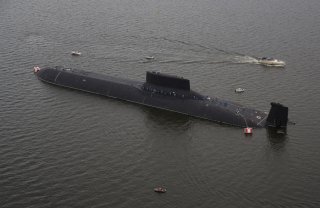The Russian Navy Is Set to Deploy Doomsday Nuclear Torpedo Drones
Poseidon is a nuclear-powered underwater drone armed with a two-megaton atomic payload.
Here's What You Need to Remember: While its Belgorod carrier appears to be well on the way to deployment readiness, little is known about the production status and delivery timeline of the Poseidon drone itself.
The first special-purpose submarine to house Russia’s Poseidon nuclear drones has been given its post-trials assignment, bringing the upcoming weapon of mass destruction one step closer to deployment.
Citing a source close to Russia’s Defense Ministry, Russian state news outlet TASS reported earlier this week that the Belgorod special-purpose submarine will be commissioned to enter service in Russia’s Pacific Fleet after it passes state trials. “According to preliminary information, the Belgorod submarine will serve in the Pacific Ocean after commissioning. However, it would be able to perform missions in any location of the World Ocean,” the source said. Belgorod is slated to enter state trials in May 2021, following a delay reportedly brought on by the coronavirus pandemic.
The Belgorod is a massive, bespoke special-purpose vessel that was built from the hull of an unfinished Oscar-II cruise missile submarine. It can reportedly house everything from Losharik mini-submarines to Klavesin-2R underwater drone submarines. It appears that the Belgorod—the first submarine to carry Poseidon drones—can accommodate as many as six units. Russia plans to deploy just over thirty Poseidon drones in total. With its unique construction history, the Belgorod cannot easily be reproduced; it would not be cost-efficient to do so in any case. Instead, the Navy has laid plans for a new line of submarines specially built to accommodate Poseidon drones. The Khabarovsk class, also known as Project 09851, is widely expected to consist of four submarines that displace around ten thousand tons and are capable of carrying up to eight Poseidon drones. The lead submarine Khabarovsk is expected to be commissioned in 2023, with the second—Ulyanovsk—to follow by 2027. No production timeline has been provided for the remaining two Khabarovsk vessels. Given the long-term nature of this project, there is a possibility that the follow-up vessels to the Khabarovsk will differ substantially from the former and be designated as part of a different class to reflect those potential changes.
One of the six new weapons unveiled by Russian president Vladimir Putin during his 2018 state address, Poseidon is a nuclear-powered underwater drone armed with a two-megaton atomic payload. The warhead can be detonated “thousands of feet”' below the surface and is meant to generate a radioactive tsunami capable of contaminating everything within a substantial area of effect. Capable of destroying large coastal cities, Poseidon poses an obvious strategic threat against U.S. infrastructure. Boasting a reported top speed of two hundred kilometers and a maximum depth of one kilometer, the Kremlin believes that Poseidon travels too fast and too deep to be reliably intercepted; it can also execute “three-dimensional” evasive maneuvers to further boost its survivability. Russian military experts have noted that Poseidon could also have battlefield use as a tactical weapon against U.S. carrier strike groups (CSG’s) and other North Atlantic Treaty Organization (NATO) maritime assets.
While its Belgorod carrier appears to be well on the way to deployment readiness, little is known about the production status and delivery timeline of the Poseidon drone itself. Substantive updates have been few and far between; Russia’s Defense Ministry published a thirty-second clip in 2019 titled “Field tests of the Poseidon complex,” but the footage scarcely revealed any new information.
Mark Episkopos is a national security reporter for the National Interest. This article first appeared earlier this year.
Image: Reuters

